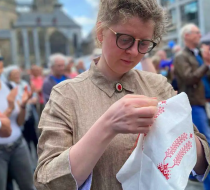Artist Rufina Bazlova uses embroidery as a form of ‘gentle protest’ Favorite
Rufina Bazlova is not afraid to surrender her art to activism. Born in Belarus, a former Soviet republic ruled by the authoritarian leader Aleksandr Lukashenko for 29 years now, Bazlova knows all too well that being apolitical is a privilege many Eastern Europeans cannot afford. 2020 was a pivotal year for Belarus, not only because of the COVID-19 pandemic but also the presidential elections, which declared Lukashenko president for the sixth time. Widespread electoral fraud and repression against the opposition leaders caused a massive national protest in the country—the biggest in Belarus history—lasting for ten months, from May 2020 to March 2021. Despite the peaceful nature of the protests, the government’s response was brutal: human rights organizations documented more than 1,000 cases of torture, while hundreds of protesters were detained as political prisoners. Nine people died as a result of the 2020 Belarusian protests. As a response to the government’s brutality, Bazlova created a project dedicated to these events, The History of Belarusian Vyzhyvanka, a wordplay of vyshyvanka, the name of traditional Belarusian embroidery, and vyzhyvat, “survive” in Russian. The name, invented accidentally in a conversation with a foreign journalist, stuck to the project, encompassing the tragic nature of the events at the center of the series. he History of Belarusian Vyzhyvanka started in 2020 as a series of digitally created embroidery schemes documenting the events of the protest in a style of traditional Belarusian embroidery patterns.
Bazlova, who has lived and worked in Czechia since 2008, got into embroidery aesthetics in 2012. She was inspired by the massive collection of traditional folk patterns of Belarus assembled by Mikhail Katsar, whose book on Belarusian textiles attempts at decoding the meanings and narratives in folk art. Patterns documented by Katsar from the 19th century and earlier focus on the art of illiterate peasant women who used embroidery and weaving to tell stories important for rural communities—on harvesting, love, and religion. The rhomboid shapes symbolizing Sun, Nature, Earth, or triangle female figures influenced Bazlova’s graphic approach. For the artist, the narrative potential of traditional Belarusian ornaments seems extremely productive in telling the contemporary history of her country.
Initially digital, some of Bazlova’s schemes are hand embroidered. Yet for Bazlova, the craft and digital realms of the work are equally important. In August 2020, she animated her images in collaboration with Olga Tesliuk. A work called There Is No Internet Connection in Belarus tells another protest episode: In the first days of the uprising, the government shut down the Internet in Minsk to prevent people from reporting police brutality and other events. “My colleague came up with the idea of a Belarusian take on the Chrome Dino game, which appears in the browser when there is no connection,” Bazlova explains. The 8-bit style of the original Google game is reminiscent of the cross-stitch embroidery technique of Belarusian vyshyvanka. When the protests were brutally suppressed and the opposition leaders were detained or had to flee the country, the repression went on. After finishing The History of Belarusian Vyzhyvanka, Bazlova decided to continue working on the topic of political prisoners. Framed in Belarus is a series of embroidery schemes, each depicting a story of a political prisoner of the Belarusian regime. Bazlova invites people around the globe to participate by embroidering the schemes. She sees this collective action as a healing practice for both prisoners and participants. Out of 500 schemes, approximately 380 portraits have been embroidered so far. Creating a wide network around the project, Bazlova gives away part of her artistic ego to the activist cause, placing collective political goals above individualistic artistic ambition. “I use folk embroidery technique, and I tell a people’s story. So why not do this project together with the people?”








